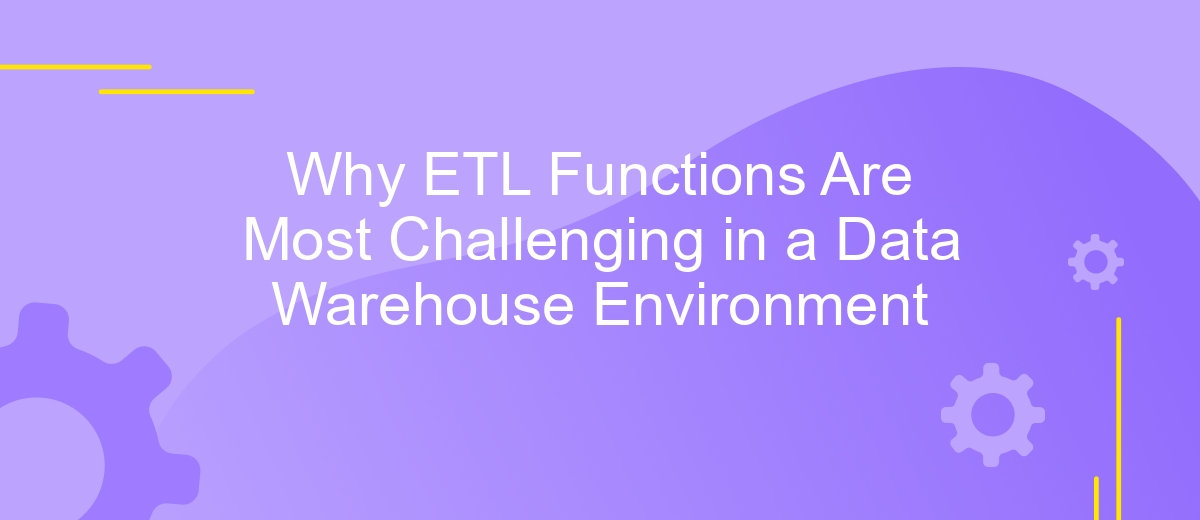Why ETL Functions Are Most Challenging in a Data Warehouse Environment
In the complex landscape of data management, ETL (Extract, Transform, Load) functions stand out as particularly challenging within a data warehouse environment. These processes are crucial for integrating disparate data sources, ensuring data quality, and making information accessible for analysis. This article explores the unique difficulties faced during ETL operations and why mastering them is essential for any robust data warehousing strategy.
Introduction
The process of Extract, Transform, Load (ETL) is a cornerstone in the management of data warehouses. As organizations increasingly rely on data-driven decision-making, the complexity and importance of ETL functions have grown exponentially. These functions are critical for ensuring that data is accurately extracted from various sources, transformed into a usable format, and loaded into the data warehouse efficiently.
- Data Volume and Variety: Handling large volumes and diverse types of data.
- Data Quality: Ensuring the accuracy and consistency of data.
- Integration: Connecting multiple data sources and systems.
- Scalability: Adapting to growing data needs and user demands.
- Performance: Maintaining speed and efficiency during data processing.
One of the services that can significantly ease the integration challenges in ETL processes is ApiX-Drive. This tool allows seamless connection between various data sources and applications, automating data flows and reducing manual intervention. By leveraging such services, organizations can streamline their ETL operations, ensuring more reliable and timely data availability for analytics and decision-making.
Challenges of ETL in Data Warehouses

ETL (Extract, Transform, Load) processes in data warehouses present numerous challenges due to the complexity and volume of data involved. One primary challenge is the extraction of data from diverse sources, which often have different formats and structures. This requires robust data integration tools and techniques to ensure data consistency and accuracy. Additionally, the transformation phase is resource-intensive, requiring significant computational power to cleanse, format, and aggregate data before loading it into the warehouse.
Another significant challenge is maintaining data quality throughout the ETL process. Data must be validated and cleansed to remove duplicates, errors, and inconsistencies. Moreover, the ETL process must be optimized for performance to handle large datasets efficiently. Integration services like ApiX-Drive can simplify these tasks by providing automated solutions for data extraction, transformation, and loading, ensuring seamless integration between various data sources and the data warehouse. This helps reduce manual intervention and enhances the overall efficiency and reliability of the ETL process.
Common Solutions to ETL Challenges

Addressing ETL challenges in a data warehouse environment requires a combination of best practices and effective tools. By adopting these solutions, organizations can streamline their ETL processes and enhance data quality.
- Automate ETL Processes: Utilize ETL automation tools to minimize manual intervention and reduce errors. Tools like ApiX-Drive can help automate data integration, ensuring seamless data flow between various sources and destinations.
- Implement Data Quality Checks: Regularly perform data validation and cleansing to maintain high data quality. This includes removing duplicates, correcting errors, and standardizing data formats.
- Scalable Infrastructure: Invest in scalable infrastructure that can handle growing data volumes and complex transformations. Cloud-based solutions can provide the necessary flexibility and scalability.
- Monitor and Optimize Performance: Continuously monitor ETL processes to identify bottlenecks and optimize performance. Use performance metrics and analytics to make informed decisions.
By leveraging these solutions, organizations can overcome common ETL challenges and ensure their data warehouse environment remains efficient and reliable. Effective ETL management leads to better decision-making and a more robust data infrastructure.
Best Practices for Efficient ETL in Data Warehouses

Efficient ETL processes are crucial for maintaining the integrity and performance of a data warehouse. One of the best practices is to ensure that data extraction, transformation, and loading are optimized to handle large volumes of data without causing bottlenecks.
To achieve this, it's essential to implement robust data validation and cleansing procedures. This helps in maintaining the quality and consistency of the data being loaded into the warehouse. Additionally, scheduling ETL processes during off-peak hours can significantly reduce the impact on system performance.
- Automate ETL processes to minimize manual intervention and errors.
- Utilize incremental loading to update only the changed data, saving time and resources.
- Leverage parallel processing to speed up data transformations and loading.
- Monitor ETL workflows continuously to detect and resolve issues promptly.
For seamless integration and automation of ETL tasks, consider using tools like ApiX-Drive. This service simplifies the configuration of data integrations, allowing you to connect various data sources effortlessly and ensure smooth data flow into your warehouse. By following these best practices, you can enhance the efficiency and reliability of your ETL processes.
- Automate the work of an online store or landing
- Empower through integration
- Don't spend money on programmers and integrators
- Save time by automating routine tasks
Conclusion
In conclusion, the complexities inherent in ETL functions within a data warehouse environment stem from the need to handle vast amounts of data from diverse sources, ensuring accuracy, consistency, and timeliness. The process involves intricate transformation rules, data cleansing, and the orchestration of multiple data flows, which can be both resource-intensive and time-consuming. This intricate web of tasks requires robust tools and skilled personnel to manage effectively.
To alleviate some of these challenges, leveraging integration services like ApiX-Drive can be highly beneficial. ApiX-Drive simplifies the integration process by automating data transfers between various platforms, thereby reducing manual effort and minimizing errors. By streamlining data workflows, such services enable organizations to focus more on deriving actionable insights from their data rather than getting bogged down by the complexities of ETL processes. Ultimately, the right tools and strategies can transform these challenges into opportunities for enhanced data management and business intelligence.
FAQ
Why are ETL functions most challenging in a data warehouse environment?
What are the common issues faced during the ETL process?
How can data quality be maintained during ETL processes?
What role does automation play in ETL processes?
How can performance issues in ETL processes be addressed?
Apix-Drive is a simple and efficient system connector that will help you automate routine tasks and optimize business processes. You can save time and money, direct these resources to more important purposes. Test ApiX-Drive and make sure that this tool will relieve your employees and after 5 minutes of settings your business will start working faster.


